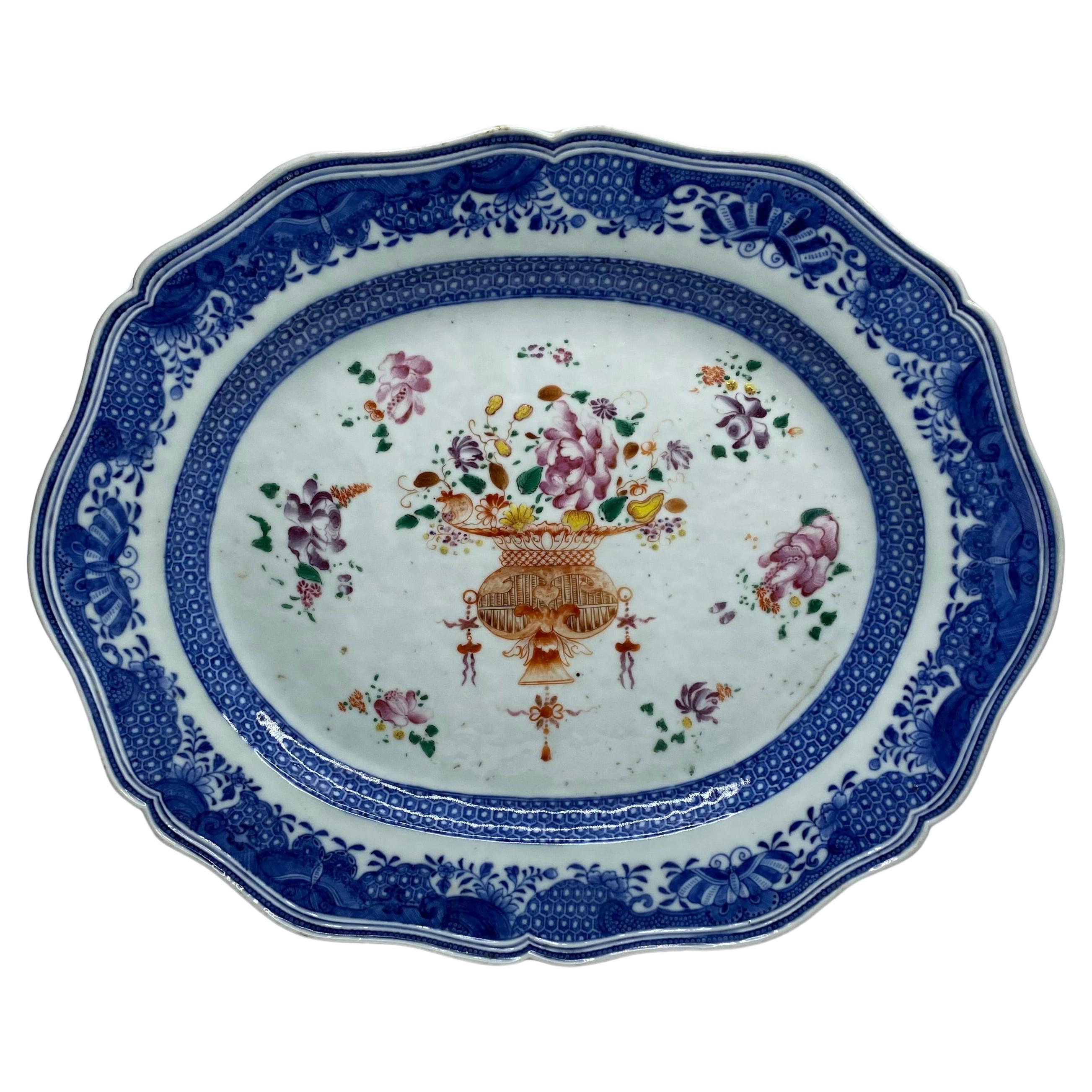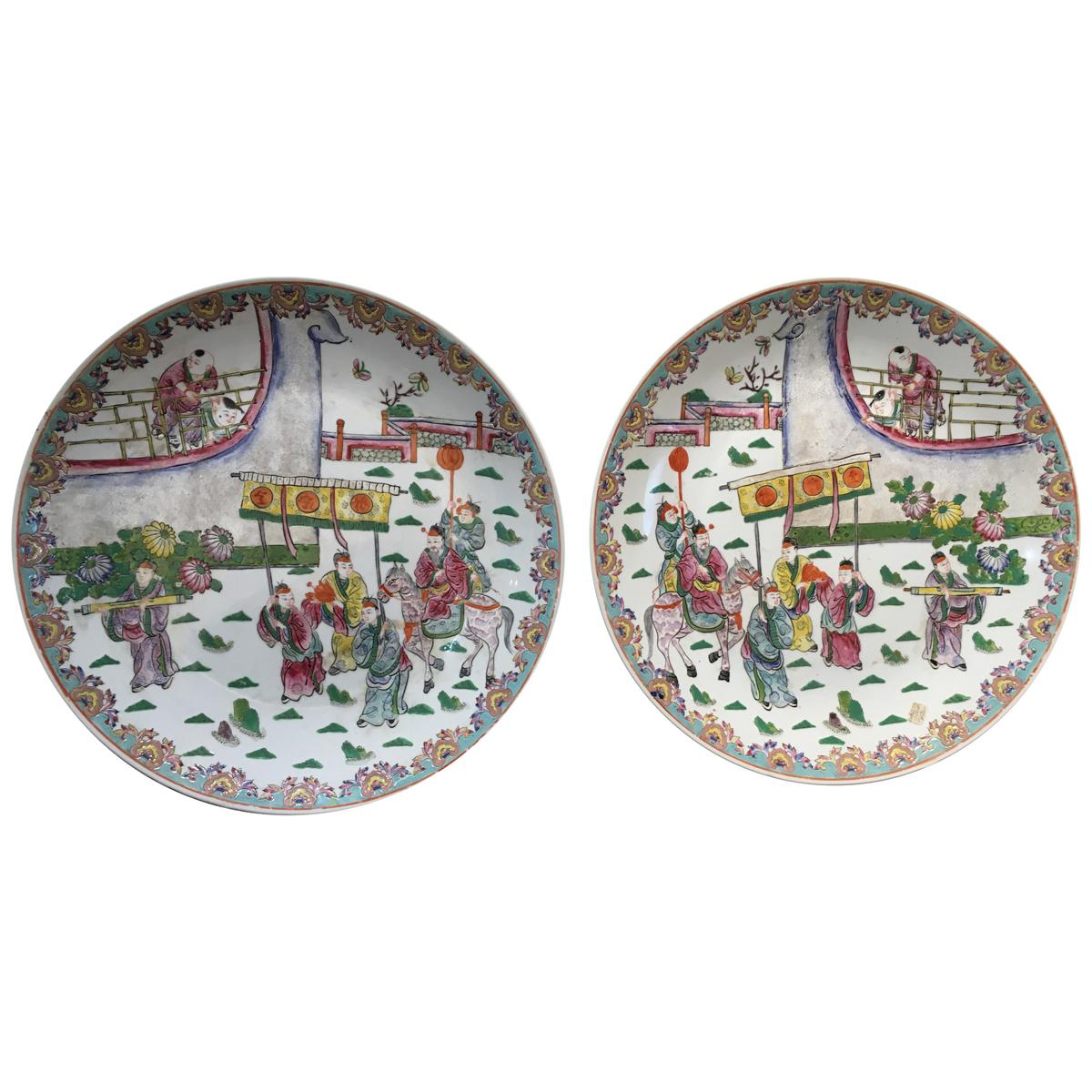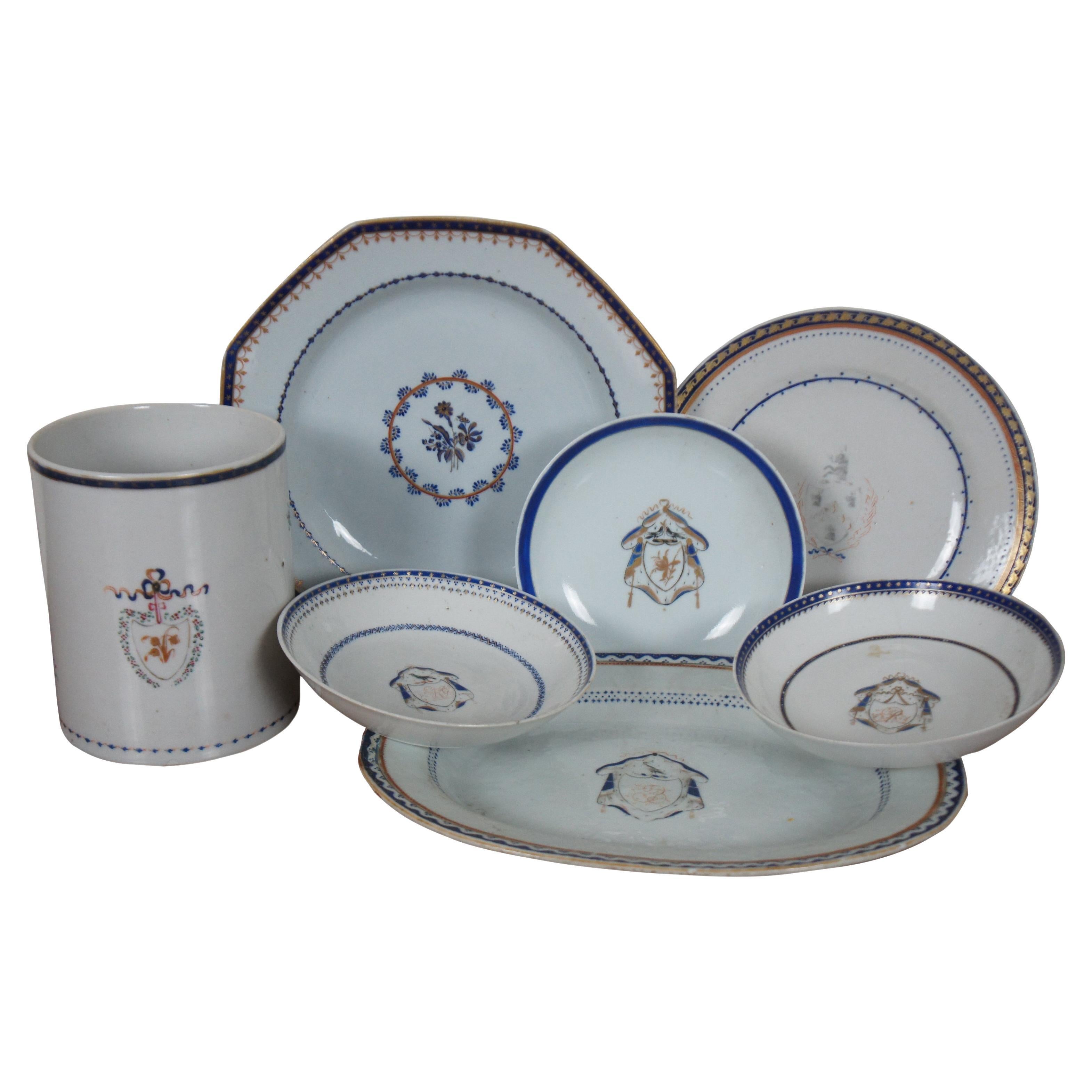Items Similar to Pair Superb Chinese 18th Porcelain Double Peacock Platter Famille Rose Qianlong
Want more images or videos?
Request additional images or videos from the seller
1 of 7
Pair Superb Chinese 18th Porcelain Double Peacock Platter Famille Rose Qianlong
About the Item
A Pair of Chinese famille rose 18th century Porcelain double peacock Platters. Qianlong
Hand painted in the classic pattern showing a peacock and peahen perched on rockwork in a garden growing with large, lush peony blooms alongside smaller flowers, the octagonal rims enamelled with floral sprays.
Country:China
Period :Qianlong (1735-1795)
Material:
PorcelainDimension: 32.5 cm x 23 cm
It is known as the "Peacock service", due to the peacocks on the rocks and also as the "Traveler Service"It is a service known as a "traveller", because it was taken from China to Portugal, and from Portugal to Brazil, when John VI, then Prince of Portugal, alarmed by the Peninsular War, moved to Rio de Janeiro with his mother, Queen Mary I. In Brazil, it was used in the Paço de São Cristóvão
The Chinese porcelain services for imperial use, brought to Brazil by King John were dispersed after the Proclamation of the Republic, and as such they have become extremely rare pieces, largely sought by collectors from all over the world.
Currently, pieces are sold mostly by the main auctioneers of Europe and the United States. A search on the Internet shows that many pieces have been sold in the last 20 years by Sotheby's, Bonham's, Christie's and Bukowskis auction houses.
Pieces of this specific service are also part of the porcelain collection of the Nathaniel Russell House Museum in Charleston, in the United States, as well as of the Historical National Museum of Brazil and the Ema Klabin Foundation.
- Dimensions:Height: 1.19 in (3 cm)Width: 9.06 in (23 cm)Depth: 12.8 in (32.5 cm)
- Style:Chinese Export (Of the Period)
- Materials and Techniques:
- Place of Origin:
- Period:
- Date of Manufacture:1750
- Condition:Wear consistent with age and use.
- Seller Location:London, GB
- Reference Number:1stDibs: LU6578232401172
About the Seller
No Reviews Yet
Vetted Seller
These experienced sellers undergo a comprehensive evaluation by our team of in-house experts.
1stDibs seller since 2022
- ShippingRetrieving quote...Ships From: London, United Kingdom
- Return PolicyA return for this item may be initiated within 14 days of delivery.
More From This SellerView All
- Baroque Brazilian Sculpture by Antonio Francisco Lisboa “Aleijadinho” 18th centuLocated in London, GBA very rare Baroque wooden carved sculpture by the Brazilian sculptor Antônio Francisco Lisboa, known as “Aleijadinho” (1738-1814) Original polychrome detailing Circa 1790 Height 1...Category
Antique 18th Century Brazilian Baroque Figurative Sculptures
MaterialsWood
- Magnificent Sinhalese Portuguese Kastane Rhino Ceremonial Ceylon Sword 17th CLocated in London, GBA magnificent 17th century Ceremonial Sri Lankan Kastane sword with Rhino handle and gold and silver Portuguese inlayed blade. A kasthane is a short traditional ceremonial or decorative single-edged Sri Lankan sword. The sword is featured in the Flag of Sri Lanka. The main aspect of this Kastane Hilts shows the central monster accompanied by supporting minor iconic forms and the peculiar guard arrangement incorporating Buddhist style Vajra quillons. The scabbard of this Kastane sword is made of Rhino horn and is decorated with brass, silver and gold. It is a testament to the skill of the traditional craftsmen operating in Sri Lankas ancient Royal Sword Workshops. The sword measures 75cm in length The Dutch East India Company (VOC or Vereenigde Oost-indische Compagnie in Dutch) regularly gifted swords to the Kandyan court as part of their strategy to protect their trading privileges. Many of these swords had the traditional Sinhalese decoration but with VOC-marked blades. From 1467 to 1818, Kandy was an independent kingdom in Ceylon—present-day Sri Lanka. In the 18th century, the Kingdom of Kandy was recognized for its outstanding metalwork and craftsmanship. Unfortunately, their fine metalworking came to an end when Kandy fell under British rule in the early 19th century. The kasthane served as symbols of rank and office, presented by the king to noblemen and local chieftains. The silver-mounted kasthane was reserved for the Adigar, the highest officials or feudal lords who also acted as ministers and governors. It also served as a diplomatic gift from the court to European visitors. It was a Sri Lankan tradition to wear the kasthane as a symbol of rank to mark ceremonial occasions. However, the sword type, with an animal-decorated hilt and curved blade, was of European origin. It has its roots in the European hunting swords...Category
Antique 17th Century Sri Lankan Anglo-Indian Antiquities
MaterialsSterling Silver
- Early French Solid Silver Sterling Hip Flask 1835 ParisLocated in London, GBA magnificent solid silver and crystal hip flask with weaved wicker half cover. The cup, colar and cork tipped stopper are all hallmarked. In very good condition. The wicker is also ...Category
Antique Early 19th Century French Louis Philippe Sterling Silver
MaterialsSterling Silver
- Antique Rare Early Portuguese Porto Solid Silver Sterling Tazza 40cm SalverLocated in London, GBA Rare Early Portuguese Solid Silver Sterling Tazza in very good condition, hammered silver. Circular top on a tapering flared based foot. There is an armorial to the middle of the...Category
Antique Early 18th Century Portuguese Rococo Sterling Silver
MaterialsSterling Silver
- Max Ackermann Modernist Original Painting Germany 1935 StuttgartLocated in London, GBAn original pastel painting by the German Modernist painter Max Ackermann,(1887 - 1975) He was both painter and graphic artist of abstract works. Signed and dated Born in 1887 in B...Category
Vintage 1930s German Modern Paintings
MaterialsPaper
- Antique Ceremonial Ashanti Ghana African Queens Wooden Stool mmaa dwaLocated in London, GBAn antique Ashanti ceremonial stool, carved from a single piece of wood. The up-curved seat stands on five supports, the central one pierced with small semi circles and the outer four supports carved, fretted. In very good condition Length 46cm Height 34cm Width 24cm The origin of the Ashante culture can be found in the Akan ethnic groups that inhabited West Africa around Lake Volta and the Gulf of Guinea. The Asante formed a strong confederation that developed from the late 17th century, with the founding of the city of Kumasi, and whose economy was based on trade, gold mining and slave traffic. They are the most important and larger ethnic group in Ghana and was one of the few African states capable of resisting European imperialism. Within the material heritage and furniture of the Ashante people, some of the most outstanding pieces are the ceremonial stools, being the Golden Stool...Category
Antique Early 1900s Ghanaian Tribal Tribal Art
MaterialsWood
You May Also Like
- Chinese porcelain platter, Famille rose, c. 1760. Qianlong Period.Located in Gargrave, North YorkshireChinese porcelain serving plate, c. 1760, Qianlong Period. The centre painted in famille rose enamels, with a large elaborate basket of flowers and fruit, surrounded by sprigs of flo...Category
Antique 1760s Chinese Qing Porcelain
MaterialsPorcelain
- Pair of Famille Rose Chinese Porcelain Charger or PlatterLocated in Nantucket, MAVery rare to find a true pair of Famille rose porcelain chargers. Look closely, there is a left hand view and right hand view. Scene depicts an important arrival complete with entour...Category
Late 20th Century Chinese Chinese Export Ceramics
MaterialsPorcelain
- 2 Antique 18th Century Chinese Export Qianlong Famille Dinner Charger PlatesLocated in Dayton, OHPair of antique late 18th century to early 19th century Chinese export Qing (Qianlong Period, circa 1780) porcelain dinner plates with hand painted famille and lattice motifs. Measur...Category
Antique Late 18th Century Chinese Export Dinner Plates
MaterialsPorcelain
- Chinese Export Qing Qianlong Famille Rose Medallion Porcelain BowlLocated in New York, NYThis finely decorated Qing-period rose medallion or rose mandarin bowl is beautifully hand-painted with four vignettes depicting courtly scenes.Category
Antique 1770s Chinese Qing Porcelain
MaterialsPorcelain
- 7 Antique 18th Century Chinese Export Qianlong Armorial Federal Porcelain ChinaLocated in Dayton, OHLot of seven late 18th to early 19th century Chinese Export (Qianlong Period, circa 1780) porcelain pieces in an American federal style with blue and gold motifs and armorial crest c...Category
Antique Late 18th Century Chinese Export Ceramics
MaterialsPorcelain
- Pair of 18th Century Chinese & Meissen Famille Verte Porcelain PlatesBy Meissen PorcelainLocated in Fort Lauderdale, FLA pair of famille verte porcelain plates, the left made in China during the Kangxi period (r. 1662–1722) and the right a copy by Meissen made circa 1740. Chinese porcelain has alw...Category
Antique Early 18th Century Chinese Chinese Export Ceramics
MaterialsPorcelain
Recently Viewed
View AllMore Ways To Browse
Silver Auction
Queen Of Roses
Pair Peacocks
Pair Of Peacocks
Hand Painted Imperial Furniture
Antique Traveler
European Antique Auction
Peacock Pattern
Warring States Chinese
Double Rimmed Glasses
Peony Pair
The Queen Mary
18th Century Chinese Qianlong Porcelain
Qianlong Period
Peacock Ceramics
Chinese Peacock
Chinese Imperial Porcelain
Sothebys Antique Auction





